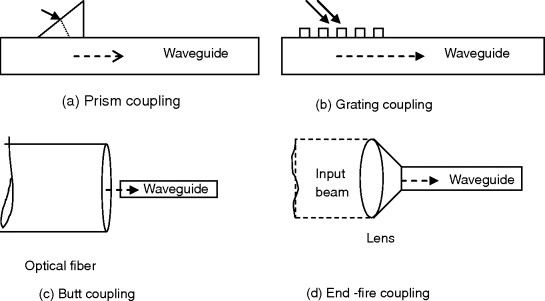10.8 Coupling to Optical Devices
One of the challenging tasks in optical systems is efficiently coupling light into and out of the OEIC. In general, light from a standard optical fiber or an external light source needs to be coupled to a silicon waveguide. A single-mode fiber core (n = 1.5) usually has a diameter of about 8 μm with a symmetric mode, while a silicon waveguide with RI = 3.45 is typically a few μms wide with an asymmetrical mode. To overcome these large differences in effective index, core size, and symmetry, various techniques are developed for efficiently coupling light from fiber to the guide. In the end-fire and butt-coupling schemes, light is simply allowed to shine onto the end faces of the waveguide. These techniques are shown schematically in Figure 10.16. In butt coupling, the two devices are simply butted, such that the mode field of the transmitting device falls onto the end face of the receiving device. In end-fire coupling, a lens is employed to focus the light beam onto the end face of the collecting device. In these two schemes, the input light beam can excite all the modes of the waveguide.
Figure 10.16 Various methods of coupling light from the fiber to waveguides: (a) prism coupling; (b) grating coupling; (c) butt coupling; and (d) end-fire coupling.

In the prism coupling and grating coupling, the input beam impinges on the guide at a specific angle, ...
Get Silicon Photonics: Fundamentals and Devices now with the O’Reilly learning platform.
O’Reilly members experience books, live events, courses curated by job role, and more from O’Reilly and nearly 200 top publishers.

